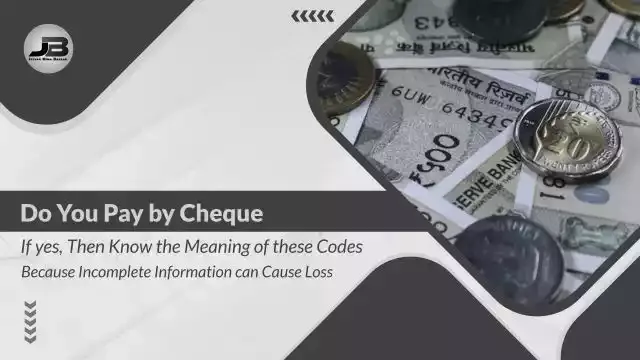Crack the Cheque Code
Pitfall-Free Handling of Incomplete Information
Welcome to Jeevan Bima Bazaar! To transact in today's modern India, we have multiple modes available to make payments. If you prefer to pay through cheque, you must be aware of the different types of codes present on the cheque.
IFSC and MICR code is printed on the Cheque of every Indian bank. In this article, we will get into the topic "Meaning of Codes Printed on Cheques and Their Usefulness" in detail.
At present, most of the Indian youth prefer to transact money through online medium. Whether the amount to be paid is large or small, the use of online options for making payments has become more prevalent. Because it is considered easier, safer and most of all faster.
In this age of online payments, people have virtually forgotten how to pay by cheque. But if you give importance to the transactions done by cheque, then it is important to understand the nuances printed on the cheque. So let's get detailed information about these nuances.
What is the Code Printed on the Cheque?
First of all we have to understand what is the code printed on the cheque? In fact, the code printed on a check is a series of combinations of letters and numbers that represent different types of financial information.
What is MICR code?
The full form of MICR code is "Magnetic Ink Character Recognition". This code is found on all cheques. MICR code is specially used in the clearing process of checks in the Indian banking system.
MICR code has three parts which are as follows:
- City Information: The first three digits of the MICR code indicate the city in which the bank from which the check is drawn operates. The first three digits of the MICR code are actually the first three digits of the PIN code. Due to which the information of the city is known.
- Bank Code: The next three digits of the MICR code represent the Bank code. This three digit helps to identify the particular bank in which the account is registered.
- Branch Code: The last three digits of the MICR Code represent the Branch Code.
A special magnetic ink is used to print the MICR code on the cheque. Due to which the machines used in the functioning of banks can easily read it. When an amount is deposited or withdrawn through a cheque, the MICR code reader and scanner can instantly extract the check related information such as bank, branch office and account number. Due to which it helps in completing the transaction process in a convenient manner without any hindrance.
Having a MICR code on a check ensures the security and integrity of the transaction, as this code helps prevent financial frauds and check processing errors. Any bank or other financial institution can capture this MICR code, so that bank or financial institution can verify the efficiency of the cheque.
Understanding the MICR code and its significance is very important for businesses, institutions and individuals doing transactions through cheques. Because by doing this you can make financial transactions more secure and faster.
What is IFSC Code?
The full name of IFSC code is Indian Financial Service Code. Which is made by adding alphabets and numerical numbers. This code is used to identify Indian Bank branches participating in the Electronic Funds Transfer System in India. IFSC Code is issued by the Reserve Bank of India and assigned to the bank branches.
IFSC code is mainly used by Indian banks to do mutual transactions. In India, Real-Time Gross Settlement (RTGS), National Electronic Funds Transfer (NEFT) and Immediate Payment Service (IMPS) transactions are carried out using IFSC codes. This code helps in providing the correct information of the payee's bank branch office.
IFSC code is of 11 digits, which can basically be divided into three parts. For example, consider an IFSC code SBIN0001234.
- The first four digits of the IFSC code provide the bank information. In the above example SBIN indicates that this IFSC code belongs to State Bank of India.
- The fifth digit of the IFSC code is usually zero. Which has been kept safe for future use.
- The last six digits of the IFSC code provide the branch office information of the bank. In the given example IFSC code 01234 represents the branch office code of State Bank of India.
IFSC code plays an important role while doing online banking transactions. It helps in ensuring accurate and secure transfer of funds between banks and branch offices across India.


कोई टिप्पणी नहीं:
एक टिप्पणी भेजें
कृपया कमेंट बॉक्स में कोई भी स्पैम लिंक न डालें।